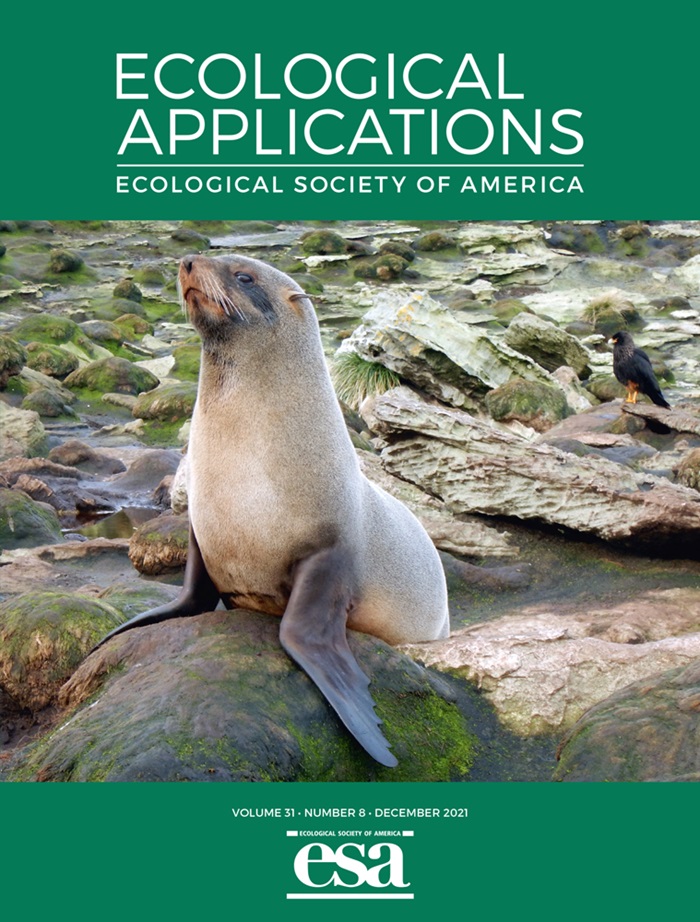本土巨型动物(北美野牛)在大平原草原上对雪松树的扩张起到了令人惊讶的抑制作用。
IF 4.3
2区 环境科学与生态学
Q1 ECOLOGY
引用次数: 0
摘要
在北美中部大平原,灭火正在导致草原向灌丛和林地的转变。这种木材侵蚀改变了植物群落组成,减少了草地生物多样性,破坏了关键的生态系统服务,并且难以逆转。原生食草动物如何影响树木的侵蚀在很大程度上是未知的,特别是与驯化食草动物相比。野牛曾经是北美分布最广的巨型动物,通常被归类为食草动物,对草的负面影响间接使木本植物受益。然而,野牛可以通过偶尔的啃食和机械干扰对木本植物产生负面影响。本研究报告了在北美大平原中部的中散草原康扎草原生物站进行的为期30年的火灾抑制和野牛存在/不存在的实验。基于遥感数据,有野牛的落叶树冠盖度较低(放牧6%比未放牧16%)。灌丛土地覆被无显著差异(放牧42% vs.未放牧41%),草本土地覆被有野牛(放牧51% vs.未放牧40%)。有美洲野牛的常绿乔木(Juniperus virginiana L.)的冠层覆盖度约为0%,而没有美洲野牛的常绿乔木的冠层覆盖度约为4%。在J. virginia幼苗的生存试验中,我们发现有野牛的越冬死亡率为40%,而没有野牛的死亡率为5%。与未放牧地区相比,野牛放牧的高地和低地的原生植物物种丰富度分别高出97%和38%。高原野牛处理的物种均匀度和Shannon’s指数较高,而低地野牛处理的物种均匀度和Shannon’s指数较低。野牛影响群落组成,导致矮草物种盖度增加,树木盖度降低。虽然人们通常认为食草动物更喜欢木本植物,但我们发现,在低火灾频率下,野牛的效果恰恰相反。我们认为,野牛的大体型和它们的行为解释了这种模式,包括践踏、角和偶尔的浏览。从保护的角度来看,野牛可能会阻碍树木的扩张,增加高草草原和类似草原的植物多样性。本文章由计算机程序翻译,如有差异,请以英文原文为准。
Native megafauna (Bison bison) act as a surprising inhibitor of cedar tree expansion in a Great Plains grassland.
In the Central Great Plains of North America, fire suppression is causing transitions from grasslands to shrublands and woodlands. This woody encroachment alters plant community composition, decreases grassland biodiversity, undermines key ecosystem services, and is difficult to reverse. How native grazers affect woody encroachment is largely unknown, especially compared to domesticated grazers. Bison were once the most widespread megafauna in North America and are typically categorized as grazers, with negative effects on grasses that indirectly benefit woody plants. However, bison can negatively impact woody plants through occasional browsing and mechanical disturbance. This study reports on a 30-year experiment at Konza Prairie Biological Station, a mesic grassland in the Central Great Plains of North America, under fire suppression and experimental presence/absence of bison. Based on remote sensing, deciduous tree canopy cover was lower with bison (6% grazed vs. 16% ungrazed). Shrub land cover showed no difference (42% grazed vs. 41% ungrazed), while herbaceous land cover was higher with bison (51% grazed vs. 40% ungrazed). Evergreen tree canopy cover (Juniperus virginiana L.), which decreases biodiversity and increases wildfire risk, was approximately 0% with bison compared to 4% without bison. In the survival trial of J. virginiana seedlings, we found a 40% overwinter mortality with bison, compared to 5% mortality without bison. Compared to ungrazed areas, native plant species richness was 97% and 38% higher in bison-grazed uplands and lowlands, respectively. Species evenness and Shannon's index were higher in the bison treatment in uplands, but not in lowlands. Bison affected community composition, resulting in higher cover of short grass species and lower tree cover. While grazers are generally assumed to favor woody plants, we found that bison had the opposite effect at low fire frequencies. We argue that the large size of bison and their behaviors account for this pattern, including trampling, horning, and occasional browsing. From a conservation perspective, bison might hamper tree expansion and increase plant diversity in tallgrass prairies and similar grasslands.
求助全文
通过发布文献求助,成功后即可免费获取论文全文。
去求助
来源期刊

Ecological Applications
环境科学-环境科学
CiteScore
9.50
自引率
2.00%
发文量
268
审稿时长
6 months
期刊介绍:
The pages of Ecological Applications are open to research and discussion papers that integrate ecological science and concepts with their application and implications. Of special interest are papers that develop the basic scientific principles on which environmental decision-making should rest, and those that discuss the application of ecological concepts to environmental problem solving, policy, and management. Papers that deal explicitly with policy matters are welcome. Interdisciplinary approaches are encouraged, as are short communications on emerging environmental challenges.
 求助内容:
求助内容: 应助结果提醒方式:
应助结果提醒方式:


